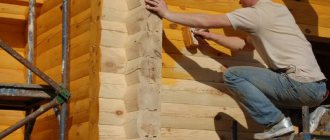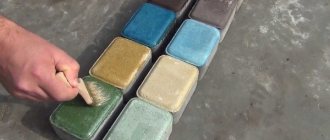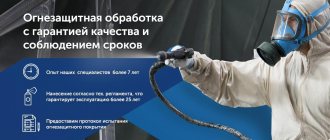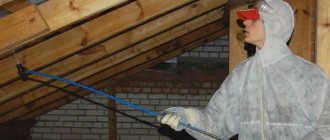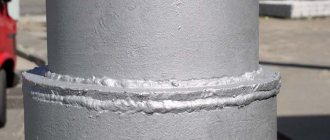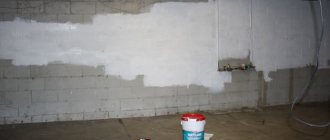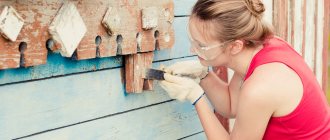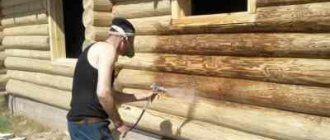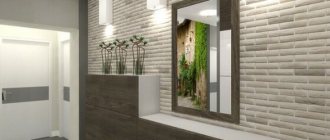Review of impregnations from different manufacturers
You can find a large selection of concrete impregnations on sale, but only some models are worthy of attention.
Strengthening primer for concrete floors Protector
The product is intended to remove dust from the surface and increase the resistance of the material to chemicals. Impregnation is in demand in the construction of concrete surfaces for various purposes. Among them:
- Floor coverings.
- Street paths.
- Runways.
Strengthening – Retroplate
The product is used to remove dust and increase the strength properties of low-grade concrete (less than M300), as well as to restore old floors with a mosaic surface.
When starting treatment with this composition, it is important to pay attention to the following features:
- Impregnation is not intended for uncured concrete (waiting time - about 2 weeks).
- Application of the composition is permitted at a temperature of at least +5°C.
The cost of 1 liter of such impregnation is 400 rubles.
Organic – Protexil
This series of impregnating solutions for concrete floors is intended for industrial buildings. It provides a high degree of protection against aggressive influences and has the following properties:
- Penetration depth - 5-10 mm.
- Consumption - 0.3 l per 1 m2.
- Operating temperature - within -40...+80°С.
- Drying interval - up to 6 hours at a temperature of +20°C.
1 liter of floor impregnation - 175-195 rubles.
Universal – Monolit 20-M
The product is water-based, so it meets all environmental safety requirements and is protected from fire.
As a result, the impregnating agent has the following effects on the concrete product:
- Improves the moisture resistance of the material by 3 grades.
- Increases wear resistance and strength by 30%.
- Eliminates the problem of concrete warping and cracking.
- Removes dust from the surface.
- Provides good adhesion.
- Increases resistance to organic acids and petroleum products.
For 1 m2 of product area, 3-5 liters of impregnation are required.
Aquastone
The product is intended for removing dust from the surface of concrete pavement and screeds based on a cement-sand mixture. Impregnation is characterized by deep penetration and guarantees an increased degree of strength and hardness. 1 l - 240 rub.
Aquasol
This impregnation of a concrete floor is intended to isolate the structure from moisture and precipitation. The cost of 1 liter of the substance is 210 rubles.
Epoxol
This is an epoxy water-dispersed impregnation that is used to increase the strength properties and protect concrete structures from destruction. With its help, you can achieve a 2-3-fold increase in strength and resistance to intense loads. Epoxol is applied to wet concrete and is indispensable for food and pharmaceutical industries, medical institutions and public buildings. 1 liter of product - 380 rub.
Ashford Formula
The product consists of water-based silicate polymers and increases the strength of concrete coatings. 1 liter of substance -110 rub.
Features of use
Hydrophobic coatings intended for concrete are applied in two ways:
- Added to the solution during its preparation. The composition is distributed evenly and binds with other elements. The output is moisture-resistant and durable hydrophobic concrete.
- The surface of ready-made concrete structures is covered with a roller or brush. It is absorbed into concrete, passing through the capillaries of living stone. Forms a durable moisture-proof film. It is used before gesso walls, wallpapering, or before applying any other decorative coating.
Before applying to the base, it is necessary to remove dust and grease from the concrete wall and dry thoroughly. Then the hydrophobic impregnation is applied with a roller or brush. After applying the first layer, you need to let the wall dry. It is allowed to begin applying decorative materials to the surface of the structure only the next day.
Some background information
Concrete, as a building material, has a low degree of water absorption. It would seem that concrete monoliths can stand and stand, but corrosion eats them up from the inside... in the concrete itself.
There are several reasons for the destruction of cement stone. They can occur separately or in combination, causing different types of destruction. Requires protection from water.
If you also insulate problem areas of joints with walls at a level of 0.3 m above the floor surface and transitions with special materials, then you don’t have to worry about destruction of the foundation and leaks.
Kawabanga! How to drill a concrete wall with a regular drill: which tool and attachment to choose, practical tips
There are a number of technologies to protect the floor:
- coating materials;
- using metal sheets;
- liquid insulating coating;
- rolled waterproofing sheets;
- dry compositions with a penetrating effect, etc.
The choice of the required technology is influenced by:
Effect provided by concrete impregnations
Organic impregnations are currently most widespread. They are acrylic, polyurethane, epoxy.
Impregnating compositions based on acrylic have good qualities at an affordable price. The concrete treated by them is not susceptible to the effects of chlorides. He is not afraid of high humidity. It has high resistance to ultraviolet radiation. During operation, the color of the concrete does not lose.
These impregnations are used to eliminate the formation of dust on concrete floors, the load on which is insignificant. This process is repeated after 2 - 3 years of operation, since the durability of acrylic-based compositions is not so great.
The best effect is achieved by impregnations made on the basis of polyurethane. They also eliminate dust and provide inertness to chemical compounds. In addition, these impregnations significantly increase the strength of concrete and make it waterproof.
The depth to which such impregnations penetrate reaches six millimeters. They can be used to impregnate concrete screeds, concrete and metlakh tiles, and bricks.
The restrictions are the conditions prohibiting the use of such compositions in open areas without canopies, as well as the mandatory presence of waterproofing under the concrete.
The use of polyurethane impregnations increases the strength of concrete products. The resistance of concrete to wear increases eight to ten times. Its ability to withstand shock loads is doubled.
Concrete becomes waterproof and resistant to chemical compounds. By eliminating the formation of dust, floor maintenance becomes easier, and the appearance of the surfaces becomes aesthetically pleasing.
Classification of impregnations
Based on their content, impregnating compositions are divided into two types:
- organic (polymer);
- inorganic (silicate).
Organic water-repellent solutions affect concrete in the following way: the binder component fills the pores, improving the material’s ability to withstand aggressive influences and enhancing the water-repellent qualities of the coating. Impregnations also solve the problem of surface dustiness and improve its strength characteristics.
Inorganic impregnating compounds act differently. They do not target pores, but interact with external molecular compounds, which then dissolve and become immune to other reactions. As a result of the interaction, concrete gains higher strength and water resistance.
When choosing an impregnating material, it is recommended to take into account the following factors:
- Inorganic compositions are used for: dust removal at low cost, with significant surface unevenness, with heavy loads on the floor.
- Organics are relevant in the following cases: constant interaction with chemicals, maintaining an attractive appearance of the coating, the need for dust removal from mosaics.
Today, organics are the most common. This is due to the better functional characteristics of organic compounds.
Different impregnations differ in the method of influencing the concrete base:
- Deep penetration impregnating compounds (silicates, silaxins, silanes) promote the fluidization of concrete. The sealing components penetrate microscopic pores and interact with lime molecules, increasing the crystallization of calcium. Thus, fluates strengthen the material from the inside.
- Liquid waterproofing compounds form a thin protective film. An example is impregnation based on acrylates. Epoxy mixtures and numerous types of polyurethane impregnations also work.
Acrylic compounds
Impregnations based on acrylates are distinguished by affordable prices and acceptable quality. They protect the material from moisture and chlorides, are resistant to ultraviolet radiation, and preserve the natural color of concrete. Acrylic compounds allow you to remove dust from the coating. However, impregnations of this type are short-lived - their effect lasts no more than 24-36 months.
Polyurethane compounds
Polyurethane is more effective than acrylates. Impregnating solutions based on polyurethane remove dust from the surface, are resistant to chemicals, are moisture resistant, and provide strength. Polyurethane solutions are used to treat not only concrete, but also cement screeds, paving areas, stone and brick objects. Polyurethane penetrates deeply into the concrete layer (up to 6 mm) and is used both indoors and outdoors.
Note! The use of polyurethane compounds implies the presence of a waterproofing layer under the concrete base, which blocks the penetration of capillary moisture into the structure of the material. After treatment with a polyurethane solution, concrete acquires several new qualities:
After treatment with a polyurethane solution, concrete acquires several new qualities:
- Strength increases to M600 level;
- wear resistance increases by 7-10 times;
- Impact resistance doubles;
- water resistance and resistance to chemicals are improved;
- dust is eliminated;
- maintenance of the coating becomes easier;
- the appearance of the surface becomes more attractive.
Polyurethane impregnating compounds are easy to use and financially beneficial. The impregnated surface begins to be used on the same day, if we are talking about pedestrian traffic. In the case of transport, you need to wait three days for the concrete to gain maximum characteristics.
Epoxy compounds
Impregnations based on epoxy resin are used only indoors, as they do not withstand exposure to ultraviolet radiation and turn yellow. The composition is a mixture of two components, which includes epoxy resin and hardener. The latter are phenols or tertiary amines. The proportions between the hardener and resin may differ depending on the consumer characteristics of the product. Compositions are offered in both colored and colorless versions.
The advantages of epoxy impregnations include the following qualities:
- high strength;
- resistance to abrasives;
- moisture resistance;
- slight shrinkage;
- no pungent odor;
- attractive appearance, as the surface resembles “wet concrete”.
The disadvantage of epoxy compounds is that they are less resistant to chemicals and mechanical loads when compared with polyurethane impregnations.
Functional characteristics of impregnations
Based on functionality, impregnating compositions are divided into the following types:
- strengthening;
- water-repellent;
- dust removal;
- coloring.
Strengthening compounds
Strengtheners are made on the basis of inorganic elements - primer silicates. They do not create a protective layer on the surface, as they penetrate deep into the structure of the material. Reinforcing compounds do not peel off and give the concrete maximum wear resistance and dust removal effect.
Until recently, deep penetration impregnations against moisture were made on the basis of potassium and sodium silicates. Modern compositions are made on the basis of lithium silicates. Such impregnations eliminate the possibility of efflorescence on the concrete surface. The material gains increased resistance to mechanical damage and moisture. Due to deep impregnation, the strength of the surface layer doubles or even triples.
Water-repellent compounds
Hydrophobizing impregnations fill the micropores of the material, preventing further moisture from entering the coating. In addition, water-repellent compounds provide the following benefits:
- “anti-mold” effect due to the content of antifungal components;
- resistance to acids and salts, ultraviolet radiation, does not form efflorescence.
Water-repellent impregnations are often used to prevent the formation of mold in hydraulic structures, such as swimming pools. Impregnations are used to protect structures used outdoors, since the peculiarities of the formulation increase the frost resistance of concrete.
Note! Water-repellent solutions do not protect the foundation from contact with groundwater. Foundation protection must be comprehensive and include waterproofing of the structure.
Dust removal compounds
Solutions of this group are used for treating open surfaces subject to significant mechanical stress. Impregnation improves the wear resistance of the material, makes it more resistant to chemicals, and makes it easier to care for the coating.
Coloring compounds
Giving concrete color is carried out using ordinary paints or special colored impregnations. Moreover, the painted surface wears out much faster. Colored solutions seep into the material to a depth of three millimeters, which makes the color lasting.
Note! The painted surface will be preserved for a long time only if the concrete is additionally impregnated with a water-repellent solution.
Everything about concrete dust removal
In fact, all impregnations represent a full-fledged independent protective layer that does not require any additional protective coatings. The layer will not become an obstacle if you need to cut reinforced concrete with diamond wheels.
The chemical basis of all impregnations are special polymer compounds.
Impregnations are used for the following purposes:
- Dust removal of concrete floors.
- Adding additional strength to a concrete structure.
- Ensuring waterproofing, that is, preventing water from penetrating into the pores.
- Preventing the floor from becoming covered with a fine network of cracks if, for example, diamond drilling of holes in concrete is required.
The concrete base is already dust-free and completely ready for use.
Types of impregnation
There are several types of impregnations, each of which has certain properties.
The following categories can be distinguished:
- Polyurethane. This concrete impregnation is the most popular among builders. This popularity is fully justified by the fact that its price is low, and the range of tasks performed is quite wide. Let's display it in the form of a table.
| Sealing | The composition allows for complete waterproofness. |
| Dust removal | Especially relevant for concrete floors. |
| Chemical resistance to external influences | The structure is completely protected from exposure to various types of chemicals. |
| Strengthening function | Allows you to significantly increase the resistance of the floor to impacts. |
| Depth | The additive penetrates deep into the protected surface. The penetration depth reaches 2-3 mm. This allows you to increase the strength characteristics of concrete to M600 and even higher. The strengthening function realizes itself in a similar way. |
| Decorativeness | The decorative effect that this substance can impart to any surface also plays a certain positive role. |
- The next type is deep penetration impregnation for concrete. Its main distinguishing feature is the ability to penetrate into the building material up to 5 times deeper than polyurethane. For example, concrete floors with average grade strength are impregnated to a depth of 5 mm.
This type is used if it is necessary to achieve the maximum possible impregnation of the surface.
This mainly applies to the following cases:
Institutions and objects where floors are subject to a large abrasive effect. In such cases, the component must penetrate as deeply as possible. It also helps protect the surface from dust.
Schematic illustration of the deep penetration principle
- Industrial products and high-strength floors have a low-porosity structure, and it is quite difficult for conventional additives to penetrate deeply. Deep penetrating impregnations are needed here.
- If it is necessary to strengthen a weak screed as much as possible, the deepest penetration is necessary.
- If there is an urgent need to apply impregnation to wet concrete, then the only possible option is deep penetrating.
- The acrylic additive is used for surfaces that are not subject to load, and if they are, the load is insignificant. An example would be utility rooms or floors covered with linoleum on top.
Applying an acrylic component to a concrete surface
Impregnations have also found their application in the road sector. The fact is that constant repair of roads is a labor-intensive process. To reduce repair work to a minimum and significantly increase the strength of the surface layer of the roadway, it makes sense to use impregnations for asphalt concrete.
This is what asphalt concrete looks like before and after treatment
Independent work
One of the advantages of impregnations is the fact that all the work involved in adding them can be done independently.
The instructions divide the entire work process into the following stages:
- Preparatory work that includes removing all debris.
- The composition is poured onto the floor and try to distribute it as evenly as possible over the entire surface with brushes. You can also apply the composition with a padding roller.
- The composition is left on the floor for 1 hour for initial impregnation to occur. Then a little water is added to the composition and re-distributed (lithium impregnations do not require re-distribution).
- After 20 minutes, excess mixture is removed using a squeegee, and the floor is thoroughly washed with water.
Self-application of the composition to the surface of the frozen solution
How do you protect concrete from moisture?
To effectively protect concrete from moisture penetration, it is necessary to use special products that have increased penetrating quality.
- The mixtures consist of fillers, Portland cements and other chemically active additives.
- The main feature of the materials is their ease of use and the ability to easily use the funds during construction work.
Impregnated concrete base
- The main task of waterproofing is to effectively protect concrete from moisture penetration. If the concrete is water-repellent, the frost resistance indicators will increase significantly.
Impregnations for concrete protection have various compositions and are intended for waterproofing work.
What types of water repellents are there?
There are different types of water repellents on the modern market. The main ones are water-based and silicone compounds.
- It is necessary to carefully read the contents of the mixture, since different products are used for different construction tasks.
- Most experts note a high demand for silicone water-repellents due to their unique properties.
- It does not limit air exchange, creates durable protection for building materials, and promotes effective protection against moisture.
Destruction of concrete samples from moisture
- The water mixture also has a number of main advantages. It gives a more improved appearance to the processed building materials and is resistant to negative influences.
- Such mixtures are light and safe. It is important to make the right choice of additive based on the types of material used.
Bridges and dams are the first “testers” of impregnations
Attention! For the first time, impregnations began to be used at special-purpose facilities and in the field of bridge construction. Later, the compositions became more accessible and went into mass production, as their effectiveness was proven by numerous tests and years of successful operation of concrete products.
Operating principle of impregnations
Applying impregnation with your own hands on brick in one layer
The instructions for using such compositions are almost the same. Its essence is as follows:
- Impregnation must be applied to the product and wait until it hardens inside the concrete.
- The capillary liquid comes out, but the molecular components of the mixture pass freely into the voids.
- To improve the hydrophobicity of a building material, different substances can be combined.
Reliable properties of moisture resistance and strength are acquired through:
- increasing resistance to different temperatures;
- preventing moisture from freezing in concrete;
- protection against corrosion formations;
- favorable structural changes in the solution.
Manufacturers offer different brands of products designed for working with wet or dry materials. Usually the mixture begins to harden within 24 hours, and the temperature should not exceed 20 degrees. Before hardening, it is important to protect the necessary areas from moisture.
The video in this article will tell you how professionals apply impregnation to a concrete base.
Advantages of impregnations for concrete floors and screeds
The main effect of impregnations is to completely absorb into concrete pores, fill them and thereby strengthen the concrete. After this event, the concrete structure acquires high strength and wear resistance. As a result, dust removal from the surface also occurs.
Impregnations for concrete have the property of durability, so they can be applied only once during the entire period of operation of the concrete floor.
Another important advantage of impregnations is their protective properties. As a result of their use, the floor becomes resistant to the adverse effects of cold and various aggressive environments
Water resistance is also improved.
After applying the impregnation, the floor can be used within a few hours.
There are various impregnations, each of which has its own characteristics and properties. Let's consider the popular brands “ArmMix Hydrophobic” and “Monolit”, which are presented here: go to the website of the manufacturer and supplier of concrete impregnations “fibroblok.ru”
ArmMix Hydrophobic: purpose and advantages
Acrylic-silicone impregnation is very effectively used for treating concrete floors and cement screeds (including semi-dry ones).
The product is a type of hydrophobic impregnation. As a result of application, it has a water-repellent and strengthening effect. The liquid product does not contain toxic substances, so it can be used in any room.
Among the properties and advantages of ArmMix Hydrophobic we can highlight:
- It is a deep penetration impregnation;
- Gives concrete strength, durability and frost resistance;
- Prevents the appearance of mold and other harmful lesions;
- Reduces freezing in the winter and thereby facilitates the removal of ice from the surface;
- Protects from moisture;
- Provides breathability.
When applied, the impregnation completely fills the air pores and microcracks of concrete and thereby ensures its strength and moisture resistance.
The only disadvantage of the composition is the reduction in the adhesion of tile adhesive to the base. Therefore, if you need to impregnate the floor with acrylic impregnation, and then glue tiles or lay porcelain tiles on it, then you can use ArmMix “Universal” impregnation primer, which does not contain a silicone water repellent and is both a strengthening impregnation and an excellent adhesive composition.
Impregnation for concrete "Monolith"
Monolith 20M"
Monolith 20M is a water-based product that is harmless to human health. The composition has a characteristic lemon color and is odorless.
Penetrating deeply into the pores of concrete, Monolith 20M creates crystals in them, which begin to expand when moisture occurs. As a result, the structure acquires high moisture resistance and frost resistance. In this case, the crystals do not form any internal stress in the concrete, since their expansion occurs only in the pore space.
After applying impregnation, concrete also acquires qualities such as high strength and wear resistance.
Impregnation "Monolit 20M" is recommended for use on concrete surfaces of residential buildings, shopping centers, industrial warehouses, bridges, car repair services, parking lots and other structures, incl. increased load.
Impregnation of the Monolit-20M-L brand will help not only strengthen, but also polish the concrete floor. The product contains lithium silicate, which gives concrete all these qualities. The transparent product is perfectly absorbed into concrete (up to 40 mm) and forms crystals that have a strengthening effect. It is recommended to use this product for old concrete floors that are subject to mechanical stress or chemical influences. The composition also effectively strengthens porous concrete floors.
After applying the product, the frost resistance and durability of the concrete structure significantly increases. Dust formation is reduced to nothing. Monolit-20M-L reliably protects the floor from moisture, organic acids and petrochemical products. A floor treated with Monolith of this brand is easily polished, creating a radiant shine.
All of the above products can be purchased in the city of Dzerzhinsky, for more details visit the company’s website https://fibroblok.ru tel: 8-915-037-54-61
Your gratitude for my article is to click on any button below. Thank you!
Waterproofing a concrete floor in a private house
To waterproof residential premises, coating technology is most often used. As a rule, this is quite simple and provides the necessary protection from large amounts of moisture.
This is done simply: the floor surface is painted with polymer paint. Preferably in several layers. This paint fills all the cracks and pores of the concrete, which ensures a smooth surface.
Due to the fact that the paint has a strong odor, waterproofing should be carried out in a ventilated area.
Unlike an ordinary room, the bathroom has high humidity and the risk of water leakage. In this case, it is better to use adhesive or coating waterproofing, as they provide more reliable properties and durability.
Waterproofing concrete with “liquid glass”
Liquid glass is a substance that is a mixture of sodium and potassium silicates. The composition of liquid glass is similar to stationery glue. The silicates that make up liquid glass react with concrete components and plug microcracks in layers close to the surface.
Liquid glass is a penetrating waterproofing material. Application is very simple - using a brush or roller. You can do the work yourself. But, it should be noted that the composition is fragile after drying, so such waterproofing requires protection from mechanical damage.
Waterproofing concrete with “liquid glass”
In principle, when using high quality cement mortar and high inherent strength, as well as creating certain molding and drying conditions, it is possible to obtain practically waterproof concrete. This type of concrete is used in the construction of high-rise buildings and special-purpose structures. Under normal conditions, making such concrete is very difficult. Especially when it comes to low-rise private construction.
To increase the service life of buildings and to reduce the impact of moisture on them, waterproofing of concrete is necessary. A variety of materials can be used for this: concrete sealant; hydrophobic additives for concrete; mastic for concrete; welded or glued rolls. The main thing is that the waterproofing is selected appropriately, and the treatment is done professionally.
Installation of self-leveling polymer floor
To install a self-leveling polymer floor, it is necessary to follow the technology and sequence of actions.
The main stages of laying a polymer self-leveling floor:
- Preparation of the base - cleaning, filling minor defects, leveling, removing dust and dirt, grinding the surface. If the floor is applied to a fresh coating, you must wait 28 days after pouring.
- base - you can add fine quartz sand to it, which will improve adhesion. When the primer is applied, wait a day and remove the remaining sand with a vacuum cleaner.
- Arrangement of the base layer of the self-leveling floor - the prepared solution is simply poured onto the surface, a squeegee is used to distribute it, and air bubbles are removed with a needle roller. It is best to perform work at an ambient temperature ranging from 5 to 25 degrees Celsius.
- When the base layer has dried, a thin finishing layer of polymer is poured. There are mixtures that do not require this stage.
AquaStop Colorless
Universal water-repellent impregnation that does not change color
More details
Impregnations are recommended for use on any porous materials - concrete, natural and artificial stone, ceramic materials:
- CemAquaStop is a complex moisture-repellent product for treating the surface of limestone, slate, shell rock, brick, concrete, cement-sand plasters, sandstone, gypsum, cinder blocks, CBPB, cement-sand and clay tiles, ceramic tiles, artificial and natural stone, marble, etc. Allows you to exclude the appearance of efflorescence, increases the durability of the surface, practically eliminates its damage by fungi and mold, eliminates soaking and water absorption due to direct contact with moisture, without reducing the vapor permeability of the surface (the material “breathes”).
- AquaStone is intended for water-repellent impregnation of natural stone;
- AquaStopColorless universal product protects finely porous building materials from moisture without changing the color of the material;
- AquaStopGloss impregnation has a “wet stone effect”, giving the surface a wet look;
- AquaStopBlack impregnation tints the surface black;
- Transparent impregnation AquaStopReachColor for natural stone makes the natural color of the material brighter.
Cleaning concrete from contaminants and cleaning other building surfaces from concrete can be done in various ways, depending on the specific situation, goals, and availability of equipment. Cemmix concrete cleaning chemicals get the job done quickly and efficiently, even if you don't have the specialized equipment, and to protect your concrete, consider the Cemmix line of highly effective water-repellent treatments.
You can buy CemPlast, CemBase CEMMIX without leaving your home, with discounts from 5 to 33%!!!!
Buy on Ozon
Buy on VseInstrumenty.ru
Buy on Wildberries
Buy at Leroy Merlin
Or you can find the nearest official dealer in your region on our map
← Increasing the strength of concrete
Concrete waterproofing: in what cases is it required and what kind →
Return to list
Comments
Popular impregnating compositions
There is a huge variety of concrete primers on the market. Let's consider only the most famous of them:
- Strengthening compound "Protector". It is highly resistant to chemicals. Makes the surface stronger. Has a dust-removing effect. Improves the adhesive properties of the surface. “Protector” is used to strengthen structures for various purposes, including runways, highways, sidewalks, etc. Strengthening impregnation is offered in 20-liter containers.
- XTREME HARD. It is an inorganic based waterproofing primer. Includes silica dust that penetrates the concrete structure and interacts with the cement base. During the reaction, a crystallized mass and structures appear that block micropores.
- "Retroplate". Strengthening impregnation containing a modifier. This element is used to strengthen and remove dust from concrete structures. The primer is applied at temperatures above 5 degrees Celsius. Impregnation is incompatible with uncured concrete.
- "Protexil". Used to impregnate floors in industrial facilities. Protexil components protect concrete from the effects of mechanical damage and contact with chemicals. The impregnation layer dries in about 6 hours at an air temperature of 20 degrees.
- "Monolith 20-M". It is a universal primer. "Monolit 20M" is made on a water basis. It is environmentally friendly and fireproof. The effect of the impregnating composition can reduce the occurrence of cracks, improve water resistance, increase resistance to wear, and also remove dust from concrete. The primer penetrates 20-30 mm into the material and increases the durability of painted surfaces. Consumption of “Monolith 20 M” is approximately 1 liter for every 3-5 sq. m of concrete base.
- "Aquastone". It has a powerful dust-repellent and water-repellent effect. “Aquastone” for cement screed penetrates deeply into the structure of concrete, strengthening the material and improving its adhesive characteristics. Impregnation is possible in wet floor conditions.
- “Probetil.” Primer with water-repellent properties for materials containing a cement base. Probetil also provides resistance to chemicals.
- "Master floor." Refers to epoxy compounds. Used for dust removal and strengthening of magnesium and concrete floors, as well as cement screeds. Thanks to the use of “Master Floor”, the strength of the base is tripled. A special feature of the primer is the ability to saturate a wet floor.
- Ashford Formula. The composition includes a water-based silicate polymer. The Ashford Formula hardener is intended for treating floors subject to intense mechanical loads (industrial enterprises, roads, logistics terminals, etc.).
- "Litsil." The Russian development - "Litsil" - has the capabilities of dust removal, polishing and strengthening of concrete. It is affordable and environmentally friendly.
- "Ceresite". The Ceresit primer is used to strengthen concrete, cement screeds, and lime surfaces. Improves the adhesive properties of the material, increases the density of the surface and its resistance to moisture.
Alternative options
Impregnations have a lot of advantages, but they cost a lot. If desired, alternative methods can be used to improve the quality of concrete. The most common material is liquid glass. It has antifungal activity and creates a moisture-resistant surface. However, it does not strengthen concrete at all.
Another primer option is regular varnish. Its properties are similar to liquid glass.
Processing methods for applying protective coatings
Surface preparation and cleaning is a labor-intensive and complex technological operation, which is almost always performed before repairs and the application of intermediate, finishing layers. Concrete must be strong in tension, compression, shear, bending, have a certain moisture content, without depressions, protrusions, cracks, cavities, and foreign inclusions.
The surface must be uniform, free from mold, dust, dirt, and oils. This is the only way to achieve high quality work when applying protective, moisture-proofing, waterproofing, and decorative coatings.
Processing tasks:
- removal of easily peeling, loose layers;
- elimination of sinks, cracks;
- removing all layers that impede adhesion;
- removal of layers affected by chlorides to the depth where their content is unacceptable;
- cleaning fittings.
Criteria for assessing the condition of the foundation:
- cleanliness of the concrete surface - there should be no foreign components on the base that reduce adhesion to subsequent layers. If you wipe the concrete with a black rag, there should be no traces left on it.
- moisture control - determine the need to moisten or dry concrete. For organic solutions, the humidity should be 5%, for mineral solutions - no higher than 8%.
- temperature control – carried out in order to comply with the coating laying regime.
- the presence of laitance on the surface - if you scrape the base with a knife and dust forms, it should be cleaned, otherwise adhesion to the next layers will be insufficient.
- uniformity - if there are irregularities on the surface of more than 3 mm, they are removed or smoothed out with leveling and repair compounds.
- Concrete contamination - this can be chlorides, nitrates, sulfates, fungi, etc.
Concrete contamination is removed locally or together with salted concrete
Mechanical treatment of concrete surface
This is a universal method of influence that is used almost everywhere.
The work is carried out using:
- metal brushes;
- cutters;
- grinding wheels;
- diamond cups;
- needle hammers;
- jackhammers;
- high pressure apparatus;
- construction vacuum cleaners.
The equipment used differs in performance and power. The implementation of methods that lead to polishing is unacceptable where surface roughness is needed. In addition, mechanical processing can lead to the formation of microcracks. Well-prepared concrete should be smooth, rough, without depressions or protrusions.
It is customary to distinguish between two types of work:
- superficial – remove a layer of up to 1 mm;
- deep – remove a layer over 1 mm. Used to remove unstable layers to a depth of durable concrete. They operate by milling to a depth of 2-3 cm in one go.
Damaged concrete is removed with jackhammers.
Dry and wet sandblasting surface treatment
The method is economical and works well on simple and complex substrates. Dry sandblasting requires the use of personal protective equipment, heavily pollutes the construction site, and requires mandatory dust removal and rinsing with water.
A more convenient method is wet sandblasting using sand with water supply, for which it is better to choose devices with a capacity of 50-200 liters. There are restrictions on use if the concrete is contaminated with nitrates and sulfates. This requires dry cleaning with dust removal using construction vacuum cleaners. Productivity can vary over a wide range - 100-600 sq.m. in an hour.
Shot blasting
The method is suitable for preparing any horizontal planes; it is used less frequently on ceilings and walls. The productivity of the installations varies between 14-420 sq.m./h. The processing depth reaches 2 mm. In general, efficiency depends on the size of the shot and the power of the machines. The main disadvantage is the high cost of work and equipment.
High pressure treatment
A universal method based on cleaning concrete with water under pressure. After such exposure, the surface is freed from old coatings, dirt, paint, surface layers, and destroyed concrete to a depth of several centimeters.
High-pressure cleaners can additionally be used to clean fittings
The operating pressure in the installations varies between 200-2500 Bar . Lower settings cope with removing dirt, high pressure is used for cutting concrete. Water consumption – 10-250 l/min.
The advantages are that the method is productive, does not damage the mortgages, does not create vibration/shock loads, and does not generate dust. The disadvantage is significant water consumption.
Recommendations for use:
- installations with a pressure of 16-25 MPa - cleaning old bases from dirt, new ones - from dirt and cement laitance;
- machines with pressure up to 45 MPa – cleaning old artificial stone from dirt, damaged concrete, and rust from reinforcement;
- with a pressure of up to 100 MPa - these are trailed devices that effectively clean the reinforcement and remove the entire weak layer. The processing depth reaches 1.5 cm per pass;
- with pressure up to 250 MPa - self-propelled units used for large volumes of work.
To summarize the mechanical processing methods, concrete preparation is ensured to a depth of:
- jackhammer – 3.5-15 mm;
- mechanical cutter – 3-30 mm;
- sandblasting – 1-2 mm;
- shot blasting – 2-3 mm;
- high-pressure apparatus – 3-15 mm.
After work, the surface is checked for the presence of delaminations and voids, which are repaired by injection.
Chemical surface treatment
Chemical cleaning is difficult to manage because it is difficult to ensure uniform exposure and complete removal of the acid. If the artificial stone is heavily contaminated, other treatment methods (sandblasting, mechanical) are first used.
Solutions are rubbed into concrete with brushes . After 5 minutes, the base is washed with hot water and mechanical methods. If necessary, operations are duplicated. After chemical cleaning, the base must be checked for pH.
Recommendations for work:
- a universal solution is the use of a 10% hydrochloric acid solution with a flow rate of 0.5 l/sq.m.;
- if the concrete contains chlorides, use a solution of orthophosphoric acid 15%;
- fats and oils are removed using alkali solutions. If the concrete is contaminated with oils to its full depth, this area is removed with bumpers.
Heat treatment
Special burners are used. The method provides a processing depth of 3-6 mm. The flame temperature can reach 3200 degrees. Productivity varies between 5-60 sq.m./h.
Treatment from biologically active substances
In this case, it is better to use hot water under pressure (up to 25 MPa) or a sandblasting unit. Concrete is coated with insecticidal compounds or other preparations with biological activity.
If the surface is heavily contaminated, treatment is carried out in two working approaches, observing a technological pause of 14 days. Such work is mandatory in damp basements, bathhouses, vegetable stores, etc.
Rebar processing
When severe corrosion is detected on the reinforcement, the metal is cleaned from concrete to a depth of at least 2 cm. High-pressure installations (100 MPa and above) or fenders are used.
Processing reinforcement with needle hammers is effective in hard-to-reach places and when working in small areas
Processing of reinforcement is carried out in several ways:
- high pressure water;
- abrasive;
- metal brushes;
- needle hammers.
Water is good at removing rust from both metal and artificial stone. Together with sand, the process goes faster and the quality of work improves. The base is rough, which provides good adhesion to materials that will be used later.
Brushes are effective when working on the surface of reinforcement. If you need to remove rust from the back side, this method is not suitable. Next, treatment is carried out with rust modifiers.
Acrylic impregnation for concrete
Acrylic impregnation for concrete is rightfully considered a universal means that simultaneously protects the coating from moisture, mold and destruction.
This product belongs to the group of water repellents, and is successfully used for wooden, cement, expanded clay concrete and other substrates with a porous structure. Impregnation also removes dust from the concrete surface.
Acrylic compositions can be used for both interior and exterior work. Acrylic compounds are often used to further strengthen crumbling and fragile surfaces and porous structures.
It is for such materials that acrylic solution with silicone filler is most effective.
Thanks to deep penetration, the impregnating composition reliably seals the screed and prevents the formation of mold due to its biocidal effect.
These compounds adhere perfectly to both new and old screeds. Colorless compositions do not change the original shade, but only enhance the shine.
In practice, various pigments are widely used, which, when added to an aqueous dispersion of acrylic compounds, make it possible to obtain floors of any color. The consumption of acrylic solutions is small - about 80 g/m2.
When applying acrylic compositions, it is necessary to take into account some features. So the process of distributing such impregnation can be done manually, using a roller or soft brush, or with a sprayer.
The operating temperature ranges from 10 to 30 degrees Celsius. The humidity level during application should be 60-80%. Ideally, acrylic compositions are best secured with a polymer-based finishing varnish, since they protect the concrete from moisture and not from abrasive effects.
Polyurethane varnish can be applied one to two hours after distributing the protective solution.
Containing no organic solvents, acrylic impregnations are safe for people and the environment. They can be used in all intended premises, including hospitals and kindergartens.
It is possible to apply acrylic compounds to wet surfaces. However, they should not be very wet. For example, on a fresh base, such a composition can be used only after five days after installing the screed.
More than a hundred years have passed since concrete floors were invented. Over the entire period, not a single worthy analogue to such grounds was found. But entire technologies have emerged for strengthening cement mortars, including using polyurethane, epoxy, acrylic resins and liquid glass. This article examined only a small part of these methods.
Brands and manufacturers
When purchasing one or another type of impregnation, it is necessary, as when purchasing any building material, to look at the manufacturer. Construction is not a field where you can make mistakes and overlook little things. Therefore, the authority and name of the supplier on the market is a kind of guarantee of quality. Below is a rating of the best impregnations for such surfaces.
Among the impregnations that have due confidence:
"Tread". The main positive quality is resistance to chemical influences. Belongs to the category of strengthening. Useful quality: removes dust from the surface, allowing the material to continue to “breathe”, maintaining its vitality.
This impregnation for concrete walls and other surfaces performs so well that it is even used for treating runways.
“Retroplate” is another moisture impregnation of concrete, the main function of which is strengthening and dust removal. Working with it requires compliance with certain requirements.
Firstly, work with the composition only at air temperatures above +5 degrees. Secondly, it can be applied to concrete only two weeks after it is laid.
Floor after using Retroplate impregnation
"Monolit 20-M" is a universal water-based composition. Helps reduce mechanical damage to concrete from shrinkage, and also enhances its moisture resistance. The hardness of the material increases by a third.
Samples: one treated with “Monolith 20m”, the other not
In addition, it becomes immune to the harmful effects of fats, petroleum products and other substances that are not favorable to unprotected concrete. At the same time, impregnation improves adhesion to paints, increasing the durability of the latter.
Functions of impregnating compositions
Concrete is porous, and its strength characteristics are largely determined by the process of cement hydration. Due to the technological features of manufacturing, the pores of concrete contain a gel component of cement, moisture and air. These elements negatively affect the properties of structures made of concrete.
Due to the presence of microscopic pores, concrete has two disadvantages:
- slight hydrophobicity, as moisture penetrates through the pores;
- low density of the material, which reduces its strength.
At the modern technological stage, it has become possible to change the porous structure of concrete to a waterproof one. This is done using impregnations.
The use of impregnations allows you to solve the following problems:
- protection from the effects of aggressive chemical substances and the environment;
- increasing the strength of the material;
- increased wear resistance;
- no dust formation on the surface due to crumbling of the material;
- strengthening of aged structures;
- extending the service life of concrete products;
- more attractive appearance of concrete surfaces.
Water-repellent compounds are used for treating concrete at the following facilities:
- exhibition complexes and retail premises;
- warehouses;
- car service workshops, car washes, car parks;
- open spaces with concrete surfaces;
- livestock farms;
- industrial enterprises;
- administrative and residential buildings.
Note! Depending on the scope of application, the composition of impregnations may differ significantly
